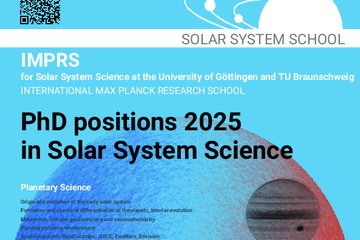All genres
41.
Journal Article
Europa's oxygen exosphere and its magnetospheric interaction. Icarus 120, pp. 317 - 325 (1996)
42.
Journal Article
The dust halo of Io. Geophysical Research Letters 23, pp. 3671 - 3674 (1996)
43.
Journal Article
Accumulation of terrestrial and outer planets. Publ. Purple Mountain Obs. 15, pp. 168 - 179 (1996)
44.
Journal Article
Exploration of the outer planets: The Galileo and Cassini missions. Publ. Purple Mountain Obs. 15, pp. 143 - 150 (1996)
45.
Journal Article
The asymmetric distribution of Titan's atomic hydrogen cloud as a function of local time. Astrophysical Journal 457, pp. 922 - 932 (1996)
46.
Journal Article
Rapid energy dissipation and variability of the Io-Jupiter electrodynamic circuit. Nature 379, pp. 323 - 325 (1996)
47.
Journal Article
HST far-ultraviolet imaging of Jupiter during the impacts of comet Shoemaker-Levy 9. Science 267, pp. 1302 - 1307 (1995)
48.
Journal Article
Imaging of H2O+ in the coma of comet Halley. Planetary and Space Science 43, pp. 699 - 708 (1995)
49.
Journal Article
Cosmic ray acceleration by protostellar winds in the Orion molecular complex. Astronomy and Astrophysics 300, pp. 283 - 288 (1995)
50.
Journal Article
The exospheric systems of Saturn's rings. Icarus 115, pp. 295 - 303 (1995)
51.
Journal Article
Implications of meteoroid-ring interactions for observations of the 1995 Saturn ring plane crossing. Icarus 117, pp. 212 - 215 (1995)
52.
Journal Article
Time variations of the Jovian synchrotron radiation following the collisional impacts of comet Shoemaker-Levy 9. 2. Flux enhancement induced by neutral atmospheric turbulence. Planetary and Space Science 43, pp. 221 - 223 (1995)
53.
Journal Article
Auroral signature of comet Shoemaker-Levy 9 in the Jovian magnetosphere. Science 267, pp. 1317 - 1320 (1995)
54.
Journal Article
On possible magnetospheric dust interactions of comet Shoemaker-Levi 9 at Jupiter. Geophysical Research Letters 21, pp. 1051 - 1054 (1994)
55.
Journal Article
On a thermodynamic origin of the cometary ion rays. Astrophysical Journal 435, pp. L143 - L154 (1994)
56.
Journal Article
Time variations of the Jovian synchrotron radiation following the collisional impacts of comet Shoemaker-Levy 9. Planetary and Space Science 42, pp. 527 - 530 (1994)
57.
Journal Article
On a thermodynamic region of the cometary ion rays. Astrophysical Journal 432, p. L143 (1994)
58.
Journal Article
Termination of the solar wind proton flow near Mars by charge exchange. Planetary and Space Science 42, pp. 435 - 440 (1994)
59.
Journal Article
The ion population between 1300 km and 230 000 km in the coma of comet P/Halley. Astronomy and Astrophysics 279, pp. 260 - 266 (1993)
60.
Journal Article
Observations of Plasma Dynamics in the Coma of P/Halley by the Giotto Ion Mass Spectrometer. Journal Geophysical Research 97, pp. 4121 - 4132 (1992)











